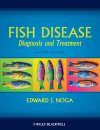![Fish Disease Fish Disease]()
Click to have a closer look
About this book
Contents
Customer reviews
Biography
Related titles
About this book
Fish Disease: Diagnosis and Treatment, Second Edition provides thorough, yet concise, descriptions of viral, bacterial, fungal, parasitic and noninfectious diseases in an exhaustive number of fish species. Now in full color with over 500 images, the book is designed as a comprehensive guide to the identification and treatment of both common and rare problems encountered during the clinical work-up. Diseases are discussed following a systems-based approach, to ensure a user-friendly and practical manual for identifying problems.
"Fish Disease: Diagnosis and Treatment, Second Edition" is the must-have reference for any aquaculturists, aquatic biologists, or fish health specialists dealing with diagnosing or treating fish diseases.
Contents
Part I. METHODS FOR DIAGNOSING FISH DISEASES 1. MAJOR CULTURED SPECIES 2. TYPES OF CULTURE SYSTEMS 3. THE CLINICAL WORK-UP 4. POST MORTEM TECHNIQUES 5. GUIDELINES FOR INTERPRETING CLINICAL FINDINGS 6. HEALTH MANAGEMENT Part II. PROBLEM LIST 7. PROBLEMS 1-10. Diagnoses made with commercially available water quality test kits or equipment that should be present in the clinician's clinic 1. Environmental hypoxia 2. Temperature stress 3. Temperature stratification 4. Ammonia poisoning 5. Nitrite poisoning 6. Nitrate poisoning 7. Too low (acidic) pH 8. Too high (alkaline) pH 9. Improper hardness 10. Improper salinity 8. PROBLEMS 11-43: Diagnoses made by either gross external examination of fish, wet mounts of skin/gills, or histopathology of skin/gills 11. Gas supersaturation 12. Lamprey infestation 13. Leech infestation 14. Copepod infestation/infection 15. Branchiuran infestation 16. Isopod infestation 17. Monogenean infestation 18. Turbellarian infection 19. Protozoan ectoparasites: General features 20. Ichthyophthirius infection 21. Cryptocaryon infection 22. Trichodinid infestation 23. Chilodonella infestation 24. Brooklynella infestation 25. Tetrahymena infection 26. Uronema infection 27. Amyloodinium infestation 28. Piscinoodinium infestation 29. Ichthyobodo infestation 30. Gill Cryptobia infestations 31. Gill amoebic infestations 32 Sessile, solitary, ectocommensal ciliate infestations 33. Sessile, colonial, ectocommensal ciliate infestations 34. Typical water mold infections 35. Atypical water mold infections 36. Branchiomycosis 37. Columnaris infection 38. Bacterial cold water disease 39. Bacterial gill disease 40. Lymphocystis 41. Epitheliocystis 42. Miscellaneous skin and gill diseases 43. Incidental findings in skin or gill wet mounts 9. PROBLEM 44: Diagnoses made by examination of a gill clip or a blood smear 44. Primary hemopathies 10. PROBLEMS 45-57: Diagnoses made by bacterial culture of kidney or affected organs 45. Bacterial dermatopathies/systemic bacterial infections (general) 46. Motile aeromonad infection 47. Furunculosis 48. Edwardsiella ictaluri 49. Edwardsiella tarda 50. Vibriosis 51. Pasteurellosis 52. Enteric redmouth disease 53 Streptococcosis 54. Bacterial kidney disease 55. Mycobacteriosis 56. Piscirickettsiosis 57. Miscellaneous systemic bacterial infections 11. PROBLEMS 58-76: Diagnoses made by necropsy of the viscera and examination of wet mounts or histopathology of internal organs 58. Digenean trematode infection: General features 59. Gill digenean trematode infections 60. Nematode infections 61. Cestode infections 62. Acanthocephalan infections 63. Myxozoan infections (General) 64. Proliferative gill disease 65. Ceratomyxosis 66. Hoferellus carassii 67. Proliferative kidney disease 68. Whirling disease 69. Miscellaneous myxozoan infections 70. Microsporidian infections 71. Ichthyophonosis 72. True fungal infections 73. Diplomonad flagellate infection 74. Tissue coccidiosis 75. Miscellaneous endoparasitic infections 76. Idiopathic epidermal proliferation/Neoplasia 12. PROBLEMS 77-88: Rule-out diagnoses 1 (Viral Infections): Presumptive diagnosis is based upon the absence of other etiologies combined with a diagnostically appropriate history, clinical signs, and/or pathology. Definitive diagnosis is based upon presumptive diagnosis combined with confirmation of viral presence (i.e., culture, immmunodiagnosis, gene test, etc.) 77. Systemic viral diseases (General) molecular probes 78. Channel catfish virus disease 79. Infectious pancreatic necrosis 80. Infectious hematopoietic necrosis 81. Viral hemorrhagic septicemia 82. Infectious salmon anemia 83. Spring viremia of carp 84. Iridovirus diseases 85. Nodavirus diseases 86. Koi herpesvirus disease 87. Alphavirus diseases 88. Miscellaneous viral infections and diseases 13. PROBLEMS 89-99: Rule-out diagnoses 2: Presumptive diagnosis is based upon the absence of other etiologies combined with a diagnostically appropriate history, clinical signs, and/or pathology. Definitive diagnosis is based upon presumptive evidence combined with further, more extensive work-up with a specific identification of the problem 89. Nutritional deficiency 90. Hypercarbia 91. Hydrogen sulfide poisoning 92. Chlorine/chloramine poisoning 93. Heavy metal poisoning 94. Cyanide poisoning 95. Miscellaneous poisonings 96. Harmful algal blooms 97. Acute ulceration response/Environmental shock/delayed mortality syndrome 98. Traumatic lesions 99. Genetic anomalies 14. PROBLEMS 100-102: Rule-out diagnoses 3: Presumptive diagnosis is based upon the absence of other etiologies combined with a diagnostically appropriate history, clinical signs, and/or pathology. Definitive diagnosis is not possible since the etiology is unknown (idiopathic) 100. Lateral Line Depigmentation 101. Senescence 102. Miscellaneous important idiopathic diseases 15. PROBLEM 103: Diseases of Reproduction 103. Egg diseases Part III. METHODS FOR TREATING FISH DISEASES 16. GENERAL CONCEPTS IN THERAPY 17 PHARMACOPOEIA APPENDIX I: Fish Disease Diagnosis Form APPENDIX II: Suppliers APPENDIX III: Scientific Names of Fish Mentioned in the Text APPENDIX IV: Definitions of Terms Index
Customer Reviews
Biography
Edward J. Noga, MS, DVM, is Professor of Aquatic Medicine (College of Veterinary Medicine) and Adjunct Professor of Zoology (College of Agriculture and Life Science) at North Carolina State University, in Raleigh, North Carolina, and Adjunct Professor of Marine Science (Center for Marine Science) at the University of North Carolina in Wilmington, North Carolina.





















![The Natural History of the Fishes of Japan [Japanese]](http://mediacdn.nhbs.com/jackets/jackets_resizer_medium/24/242707.jpg?height=150&width=98)

![Freshwater Fishes in Temperate Zone [Japanese]](http://mediacdn.nhbs.com/jackets/jackets_resizer_medium/25/250393.jpg?height=150&width=106)











